12.10: Sources of Magnetic Fields (Exercise)
( \newcommand{\kernel}{\mathrm{null}\,}\)
Conceptual Questions
12.2 The Biot-Savart Law
1. For calculating magnetic fields, what are the advantages and disadvantages of the Biot-Savart law?
2. Describe the magnetic field due to the current in two wires connected to the two terminals of a source of emf and twisted tightly around each other.
3. How can you decide if a wire is infinite?
4. Identical currents are carried in two circular loops; however, one loop has twice the diameter as the other loop. Compare the magnetic fields created by the loops at the center of each loop.
12.3 Magnetic Field Due to a Thin Straight Wire
5. How would you orient two long, straight, current-carrying wires so that there is no net magnetic force between them? (Hint: What orientation would lead to one wire not experiencing a magnetic field from the other?)
12.4 Magnetic Force between Two Parallel Currents
6. Compare and contrast the electric field of an infinite line of charge and the magnetic field of an infinite line of current.
7. Is →B constant in magnitude for points that lie on a magnetic field line?
12.5 Magnetic Field of a Current Loop
8. Is the magnetic field of a current loop uniform?
9. What happens to the length of a suspended spring when a current passes through it?
10. Two concentric circular wires with different diameters carry currents in the same direction. Describe the force on the inner wire.
12.6 Ampère’s Law
11. Is Ampère’s law valid for all closed paths? Why isn’t it normally useful for calculating a magnetic field?
12.7 Solenoids and Toroids
12. Is the magnetic field inside a toroid completely uniform? Almost uniform?
13. Explain why →B=0 inside a long, hollow copper pipe that is carrying an electric current parallel to the axis. Is →B=0 outside the pipe?
12.8 Magnetism in Matter
14. A diamagnetic material is brought close to a permanent magnet. What happens to the material?
15. If you cut a bar magnet into two pieces, will you end up with one magnet with an isolated north pole and another magnet with an isolated south pole? Explain your answer.
Problems
12.2 The Biot-Savart Law
16. A 10-A current flows through the wire shown. What is the magnitude of the magnetic field due to a 0.5-mm segment of wire as measured at (a) point A and (b) point B?
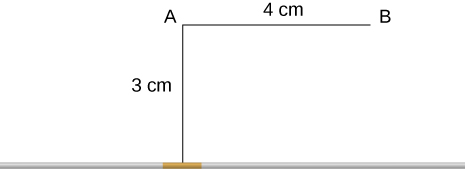
17. Ten amps flow through a square loop where each side is 20 cm in length. At each corner of the loop is a 0.01-cm segment that connects the longer wires as shown. Calculate the magnitude of the magnetic field at the center of the loop.
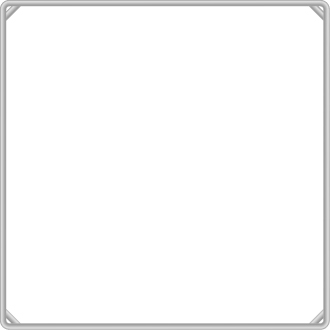
18. What is the magnetic field at P due to the current I in the wire shown?
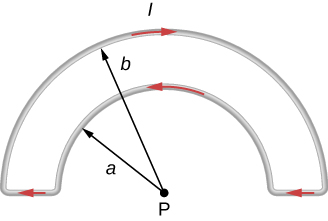
19. The accompanying figure shows a current loop consisting of two concentric circular arcs and two perpendicular radial lines. Determine the magnetic field at point P.
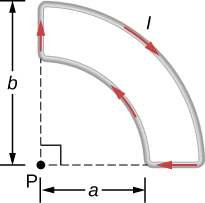
20. Find the magnetic field at the center C of the rectangular loop of wire shown in the accompanying figure.
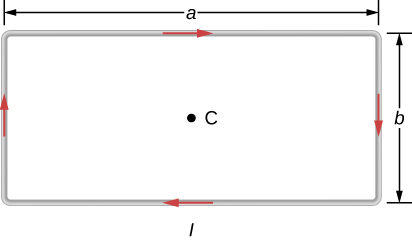
21. Two long wires, one of which has a semicircular bend of radius R, are positioned as shown in the accompanying figure. If both wires carry a current I, how far apart must their parallel sections be so that the net magnetic field at P is zero? Does the current in the straight wire flow up or down?
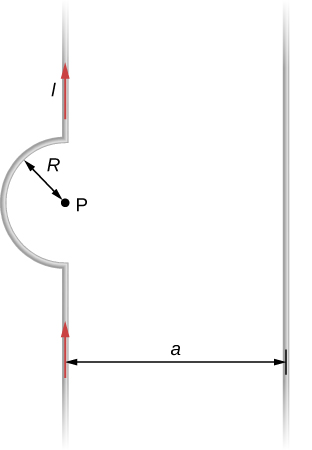
12.3 Magnetic Field Due to a Thin Straight Wire
22. A typical current in a lightning bolt is 104 A. Estimate the magnetic field 1 m from the bolt.
23. The magnitude of the magnetic field 50 cm from a long, thin, straight wire is 8.0μT. What is the current through the long wire?
24. A transmission line strung 7.0 m above the ground carries a current of 500 A. What is the magnetic field on the ground directly below the wire? Compare your answer with the magnetic field of Earth.
25. A long, straight, horizontal wire carries a left-to-right current of 20 A. If the wire is placed in a uniform magnetic field of magnitude 4.0×10−5T that is directed vertically downward, what is the resultant magnitude of the magnetic field 20 cm above the wire? 20 cm below the wire?
26. The two long, parallel wires shown in the accompanying figure carry currents in the same direction. If I1=10A and I2=20A, what is the magnetic field at point P?
27. The accompanying figure shows two long, straight, horizontal wires that are parallel and a distance 2a apart. If both wires carry current I in the same direction, (a) what is the magnetic field at P1? (b) P2?
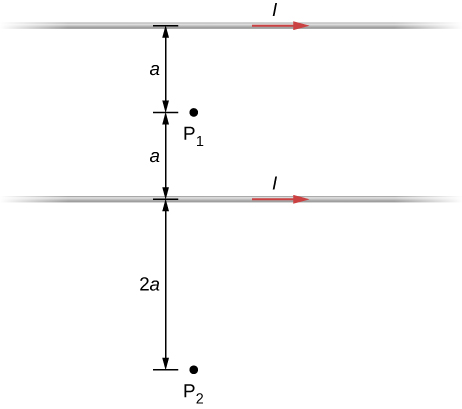
28. Repeat the calculations of the preceding problem with the direction of the current in the lower wire reversed.
29. Consider the area between the wires of the preceding problem. At what distance from the top wire is the net magnetic field a minimum? Assume that the currents are equal and flow in opposite directions.
12.4 Magnetic Force between Two Parallel Currents
30. Two long, straight wires are parallel and 25 cm apart.
(a) If each wire carries a current of 50 A in the same direction, what is the magnetic force per meter exerted on each wire?
(b) Does the force pull the wires together or push them apart?
(c) What happens if the currents flow in opposite directions?
31. Two long, straight wires are parallel and 10 cm apart. One carries a current of 2.0 A, the other a current of 5.0 A.
(a) If the two currents flow in opposite directions, what is the magnitude and direction of the force per unit length of one wire on the other?
(b) What is the magnitude and direction of the force per unit length if the currents flow in the same direction?
32. Two long, parallel wires are hung by cords of length 5.0 cm, as shown in the accompanying figure. Each wire has a mass per unit length of 30 g/m, and they carry the same current in opposite directions. What is the current if the cords hang at 6.0° with respect to the vertical?
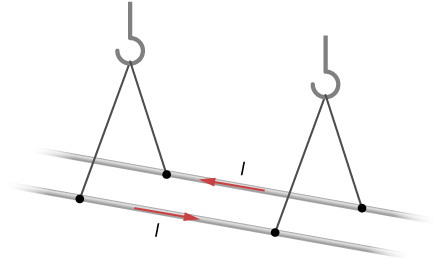
33. A circuit with current I has two long parallel wire sections that carry current in opposite directions. Find magnetic field at a point P near these wires that is a distance a from one wire and b from the other wire as shown in the figure.
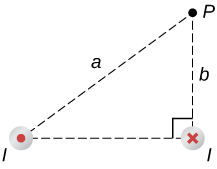
34. The infinite, straight wire shown in the accompanying figure carries a current I1. The rectangular loop, whose long sides are parallel to the wire, carries a current I2. What are the magnitude and direction of the force on the rectangular loop due to the magnetic field of the wire?
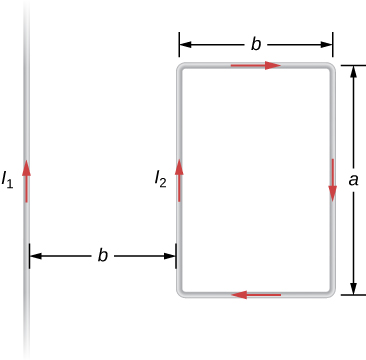
12.5 Magnetic Field of a Current Loop
35. When the current through a circular loop is 6.0 A, the magnetic field at its center is 2.0×10−4T. What is the radius of the loop?
36. How many turns must be wound on a flat, circular coil of radius 20 cm in order to produce a magnetic field of magnitude 4.0×10−5T at the center of the coil when the current through it is 0.85 A?
37. A flat, circular loop has 20 turns. The radius of the loop is 10.0 cm and the current through the wire is 0.50 A. Determine the magnitude of the magnetic field at the center of the loop.
38. A circular loop of radius R carries a current I. At what distance along the axis of the loop is the magnetic field one-half its value at the center of the loop?
39. Two flat, circular coils, each with a radius R and wound with N turns, are mounted along the same axis so that they are parallel a distance d apart. What is the magnetic field at the midpoint of the common axis if a current I flows in the same direction through each coil?
40. For the coils in the preceding problem, what is the magnetic field at the center of either coil?
12.6 Ampère’s Law
41. A current I flows around the rectangular loop shown in the accompanying figure. Evaluate ∮→B⋅→dl for the paths A, B,C, and D.

42. Evaluate ∮→B⋅→dl for each of the cases shown in the accompanying figure.
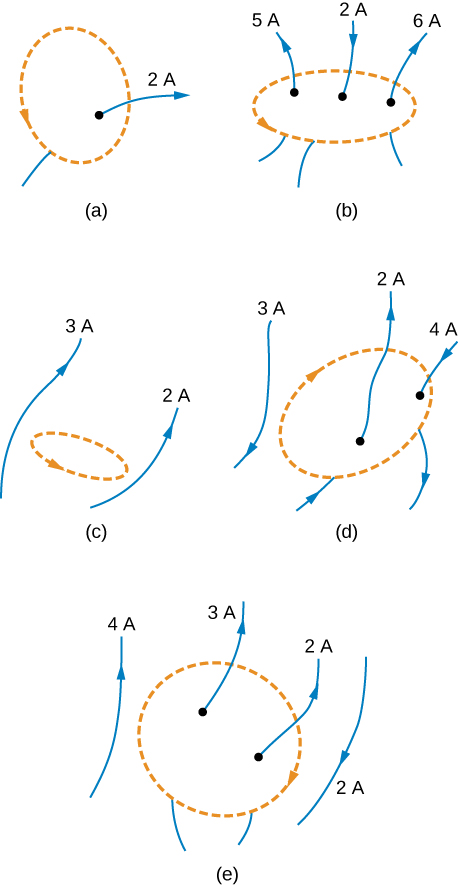
43. The coil whose lengthwise cross section is shown in the accompanying figure carries a current I and has N evenly spaced turns distributed along the length l. Evaluate ∮→B⋅→dl for the paths indicated.
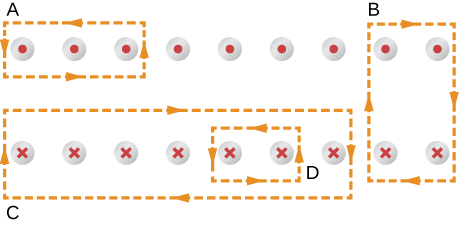
44. A superconducting wire of diameter 0.25 cm carries a current of 1000 A. What is the magnetic field just outside the wire?
45. A long, straight wire of radius R carries a current I that is distributed uniformly over the cross-section of the wire. At what distance from the axis of the wire is the magnitude of the magnetic field a maximum?
46. The accompanying figure shows a cross-section of a long, hollow, cylindrical conductor of inner radius r1=3.0cm and outer radius r2=5.0cm. A 50-A current distributed uniformly over the cross-section flows into the page. Calculate the magnetic field at r=2.0cm,r=4.0cm, and r=6.0cm.
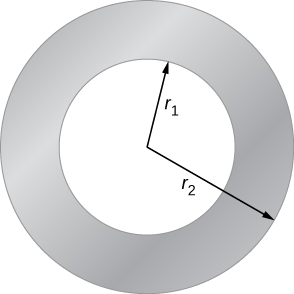
47. A long, solid, cylindrical conductor of radius 3.0 cm carries a current of 50 A distributed uniformly over its cross-section. Plot the magnetic field as a function of the radial distance r from the center of the conductor.
48. A portion of a long, cylindrical coaxial cable is shown in the accompanying figure. A current I flows down the center conductor, and this current is returned in the outer conductor. Determine the magnetic field in the regions (a) r≤r1, (b) r2≥r≥r1, (c) r3≥r≥r2, and (d) r≥r3. Assume that the current is distributed uniformly over the cross sections of the two parts of the cable.
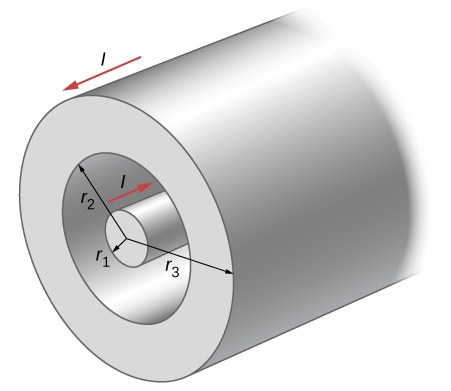
12.7 Solenoids and Toroids
49. A solenoid is wound with 2000 turns per meter. When the current is 5.2 A, what is the magnetic field within the solenoid?
50. A solenoid has 12 turns per centimeter. What current will produce a magnetic field of 2.0×10−2T within the solenoid?
51. If a current is 2.0 A, how many turns per centimeter must be wound on a solenoid in order to produce a magnetic field of 2.0×10−3T within it?
52. A solenoid is 40 cm long, has a diameter of 3.0 cm, and is wound with 500 turns. If the current through the windings is 4.0 A, what is the magnetic field at a point on the axis of the solenoid that is
(a) at the center of the solenoid,
(b) 10.0 cm from one end of the solenoid, and
(c) 5.0 cm from one end of the solenoid?
(d) Compare these answers with the infinite-solenoid case.

53. Determine the magnetic field on the central axis at the opening of a semi-infinite solenoid. (That is, take the opening to be at x=0 and the other end to be at x=∞)
54. By how much is the approximation B=μ0nI in error at the center of a solenoid that is 15.0 cm long, has a diameter of 4.0 cm, is wrapped with n turns per meter, and carries a current I?
55. A solenoid with 25 turns per centimeter carries a current I. An electron moves within the solenoid in a circle that has a radius of 2.0 cm and is perpendicular to the axis of the solenoid. If the speed of the electron is 2.0×105m/s, what is I?
56. A toroid has 250 turns of wire and carries a current of 20 A. Its inner and outer radii are 8.0 and 9.0 cm. What are the values of its magnetic field at r=8.1, 8.5, and 8.9cm?
57. A toroid with a square cross section 3.0 cm × 3.0 cm has an inner radius of 25.0 cm. It is wound with 500 turns of wire, and it carries a current of 2.0 A. What is the strength of the magnetic field at the center of the square cross section?
12.8 Magnetism in Matter
58. The magnetic field in the core of an air-filled solenoid is 1.50 T. By how much will this magnetic field decrease if the air is pumped out of the core while the current is held constant?
59. A solenoid has a ferromagnetic core, n = 1000 turns per meter, and I = 5.0 A. If B inside the solenoid is 2.0 T, what is χ for the core material?
60. A 20-A current flows through a solenoid with 2000 turns per meter. What is the magnetic field inside the solenoid if its core is (a) a vacuum and (b) filled with liquid oxygen at 90 K?
61. The magnetic dipole moment of the iron atom is about 2.1×10−23A⋅m2.
(a) Calculate the maximum magnetic dipole moment of a domain consisting of 1019 iron atoms.
(b) What current would have to flow through a single circular loop of wire of diameter 1.0 cm to produce this magnetic dipole moment?
62. Suppose you wish to produce a 1.2-T magnetic field in a toroid with an iron core for which χ=4.0×103. The toroid has a mean radius of 15 cm and is wound with 500 turns. What current is required?
63. A current of 1.5 A flows through the windings of a large, thin toroid with 200 turns per meter and a radius of 1 meter. If the toroid is filled with iron for which χ=3.0×103, what is the magnetic field within it?
64. A solenoid with an iron core is 25 cm long and is wrapped with 100 turns of wire. When the current through the solenoid is 10 A, the magnetic field inside it is 2.0 T. For this current, what is the permeability of the iron? If the current is turned off and then restored to 10 A, will the magnetic field necessarily return to 2.0 T?
Additional Problems
65. Three long, straight, parallel wires, all carrying 20 A, are positioned as shown in the accompanying figure. What is the magnitude of the magnetic field at the point P?
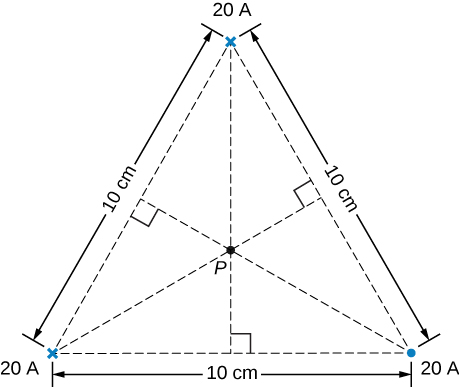
66. A current I flows around a wire bent into the shape of a square of side a. What is the magnetic field at the point P that is a distance z above the center of the square (see the accompanying figure)?
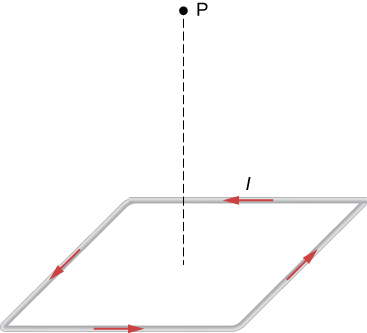
67. The accompanying figure shows a long, straight wire carrying a current of 10 A. What is the magnetic force on an electron at the instant it is 20 cm from the wire, traveling parallel to the wire with a speed of 2.0×105m/s? Describe qualitatively the subsequent motion of the electron.

68. Current flows along a thin, infinite sheet as shown in the accompanying figure. The current per unit length along the sheet is J in amperes per meter.
(a) Use the Biot-Savart law to show that B=μ0J/2 on either side of the sheet. What is the direction of →B on each side?
(b) Now use Ampère’s law to calculate the field.
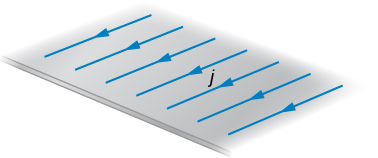
69. (a) Use the result of the previous problem to calculate the magnetic field between, above, and below the pair of infinite sheets shown in the accompanying figure.
(b) Repeat your calculations if the direction of the current in the lower sheet is reversed.
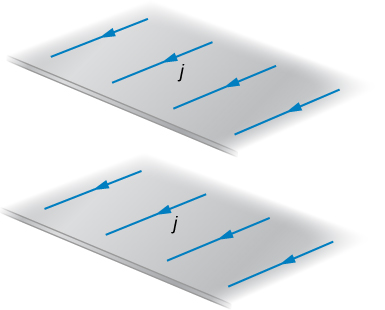
70. We often assume that the magnetic field is uniform in a region and zero everywhere else. Show that in reality it is impossible for a magnetic field to drop abruptly to zero, as illustrated in the accompanying figure. (Hint: Apply Ampère’s law over the path shown.)
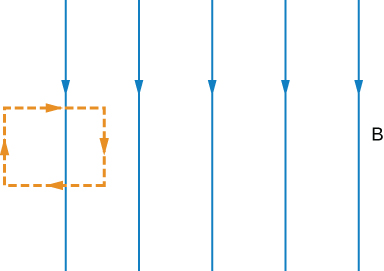
71. How is the fractional change in the strength of the magnetic field across the face of the toroid related to the fractional change in the radial distance from the axis of the toroid?
72. Show that the expression for the magnetic field of a toroid reduces to that for the field of an infinite solenoid in the limit that the central radius goes to infinity.
73. A toroid with an inner radius of 20 cm and an outer radius of 22 cm is tightly wound with one layer of wire that has a diameter of 0.25 mm.
(a) How many turns are there on the toroid?
(b) If the current through the toroid windings is 2.0 A, what is the strength of the magnetic field at the center of the toroid?
74. A wire element has vecdl,I→dl=JAdl=Jdv, where A and dv are the cross-sectional area and volume of the element, respectively. Use this, the Biot-Savart law, and J=nev to show that the magnetic field of a moving point charge q is given by:
→B=μ04πqv׈rr2.
75. A reasonably uniform magnetic field over a limited region of space can be produced with the Helmholtz coil, which consists of two parallel coils centered on the same axis. The coils are connected so that they carry the same current I. Each coil has N turns and radius R, which is also the distance between the coils.
(a) Find the magnetic field at any point on the z-axis shown in the accompanying figure.
(b) Show that dB/dz and d2B_dz2 are both zero at z = 0. (These vanishing derivatives demonstrate that the magnetic field varies only slightly near z = 0.)
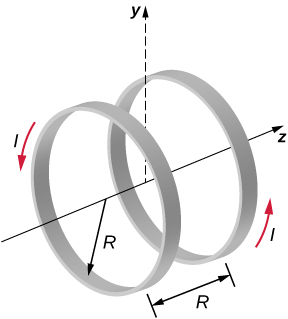
76. A charge of 4.0μC is distributed uniformly around a thin ring of insulating material. The ring has a radius of 0.20 m and rotates at 2.0×104rev/min around the axis that passes through its center and is perpendicular to the plane of the ring. What is the magnetic field at the center of the ring?
77. A thin, nonconducting disk of radius R is free to rotate around the axis that passes through its center and is perpendicular to the face of the disk. The disk is charged uniformly with a total charge q. If the disk rotates at a constant angular velocity ω, what is the magnetic field at its center?
78. Consider the disk in the previous problem. Calculate the magnetic field at a point on its central axis that is a distance y above the disk.
79. Consider the axial magnetic field By=μ0IR2/2(y2+R2)3/2 of the circular current loop shown below.
(a) Evaluate ∫a−aBydy. Also so show that lima→∞∫a−aBydy=μ0I.
(b) Can you deduce this limit without evaluating the integral? (Hint:See the accompanying figure.)
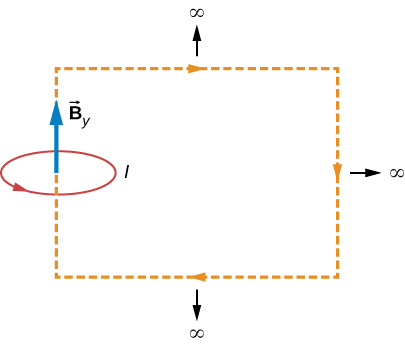
80. The current density in the long, cylindrical wire shown in the accompanying figure varies with distance r from the center of the wire according to \displaystyle J=cr, where c is a constant. (a) What is the current through the wire? (b) What is the magnetic field produced by this current for \displaystyle r≤R? For \displaystyle r≥R?
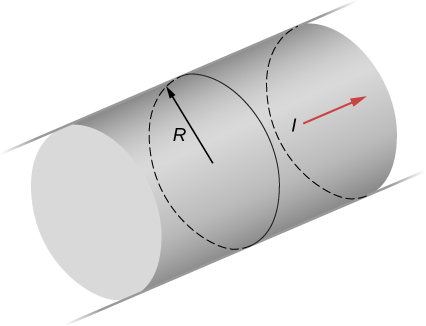
81. A long, straight, cylindrical conductor contains a cylindrical cavity whose axis is displaced by a from the axis of the conductor, as shown in the accompanying figure. The current density in the conductor is given by \displaystyle \hat{J} =J_0\hat{k}, where \displaystyle J_0 is a constant and \displaystyle \hat{k} is along the axis of the conductor. Calculate the magnetic field at an arbitrary point P in the cavity by superimposing the field of a solid cylindrical conductor with radius \displaystyle R_1 and current density \displaystyle \vec{J} onto the field of a solid cylindrical conductor with radius \displaystyle R_2 and current density \displaystyle −\vec{J}. Then use the fact that the appropriate azimuthal unit vectors can be expressed as \displaystyle \hat{θ_1}=\hat{k}×\hat{r_1} and \displaystyle \hat{θ_2}=\hat{k}×\hat{r_2} to show that everywhere inside the cavity the magnetic field is given by the constant \displaystyle \vec{B}=\frac{1}{2}μ_0J_0k×a, where \displaystyle a=r_1−r_2 and \displaystyle r_1=r_1\hat{r_1} is the position of P relative to the center of the conductor and \displaystyle 2_=r_2\vec{r_2} is the position of P relative to the center of the cavity.
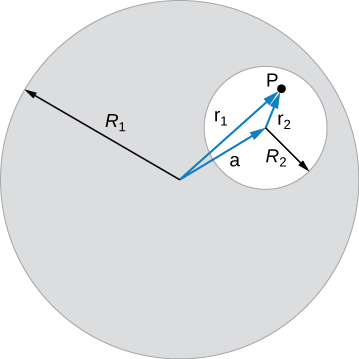
82. Between the two ends of a horseshoe magnet the field is uniform as shown in the diagram. As you move out to outside edges, the field bends. Show by Ampère’s law that the field must bend and thereby the field weakens due to these bends.
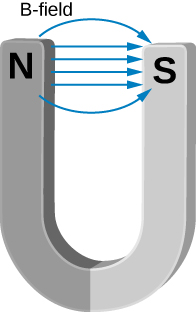
83. Show that the magnetic field of a thin wire and that of a current loop are zero if you are infinitely far away.
84. An Ampère loop is chosen as shown by dashed lines for a parallel constant magnetic field as shown by solid arrows. Calculate \displaystyle \vec{B} ⋅\vec{dl} for each side of the loop then find the entire \displaystyle ∮\vec{B} ⋅\vec{dl}. Can you think of an Ampère loop that would make the problem easier? Do those results match these?
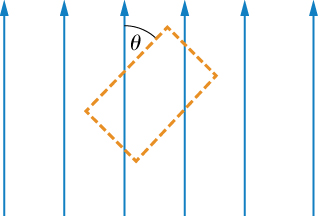
85. A very long, thick cylindrical wire of radius R carries a current density J that varies across its cross-section. The magnitude of the current density at a point a distance r from the center of the wire is given by \displaystyle J=J_0\frac{r}{R}, where \displaystyle J_0 is a constant. Find the magnetic field
(a) at a point outside the wire and
(b) at a point inside the wire. Write your answer in terms of the net current I through the wire.
86. A very long, cylindrical wire of radius a has a circular hole of radius b in it at a distance d from the center. The wire carries a uniform current of magnitude I through it. The direction of the current in the figure is out of the paper. Find the magnetic field
(a) at a point at the edge of the hole closest to the center of the thick wire,
(b) at an arbitrary point inside the hole, and
(c) at an arbitrary point outside the wire. (Hint: Think of the hole as a sum of two wires carrying current in the opposite directions.)
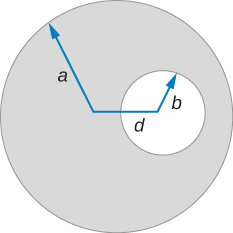
87. Magnetic field inside a torus. Consider a torus of rectangular cross-section with inner radius a and outer radius b. N turns of an insulated thin wire are wound evenly on the torus tightly all around the torus and connected to a battery producing a steady current I in the wire. Assume that the current on the top and bottom surfaces in the figure is radial, and the current on the inner and outer radii surfaces is vertical. Find the magnetic field inside the torus as a function of radial distance r from the axis.
88. Two long coaxial copper tubes, each of length L, are connected to a battery of voltage V. The inner tube has inner radius a and outer radius b, and the outer tube has inner radius c and outer radius d. The tubes are then disconnected from the battery and rotated in the same direction at angular speed of ω radians per second about their common axis. Find the magnetic field (a) at a point inside the space enclosed by the inner tube r<a, and (b) at a point between the tubes b<r<c, and (c) at a point outside the tubes r>d. (Hint: Think of copper tubes as a capacitor and find the charge density based on the voltage applied, Q=VC, \(\displaystyle C=\frac{2πε_0L}{ln(c/b)}.)
Challenge Problems
89. The accompanying figure shows a flat, infinitely long sheet of width a that carries a current I uniformly distributed across it. Find the magnetic field at the point P, which is in the plane of the sheet and at a distance x from one edge. Test your result for the limit a→0.
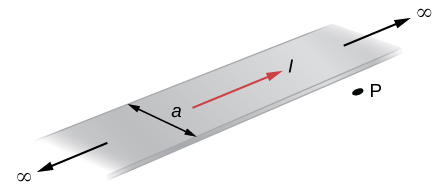
90. A hypothetical current flowing in the z-direction creates the field \displaystyle vec{B} =C[(x/y^2)\hat{i}+(1/y)\hat{j}] in the rectangular region of the xy-plane shown in the accompanying figure. Use Ampère’s law to find the current through the rectangle.
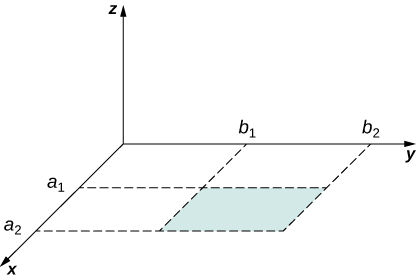
91. A nonconducting hard rubber circular disk of radius R is painted with a uniform surface charge density σ. It is rotated about its axis with angular speed ω. (a) Find the magnetic field produced at a point on the axis a distance h meters from the center of the disk. (b) Find the numerical value of magnitude of the magnetic field when \displaystyle σ=1C/m^2, R=20 cm, h=2 cm, and \displaystyle ω=400rad/sec,, and compare it with the magnitude of magnetic field of Earth, which is about 1/2 Gauss.


